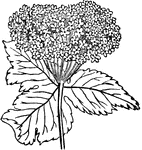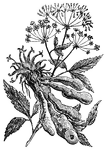Clipart tagged: ‘parsnip’

Arracacha
"A plant of the natural order Umbelliefrae, a native of the elevated table-lands in the neighborhood…

Cow Parsnip
"A genus of plants of the natural order Umbelliferae, having petals bent in at the middle, and flat…
Parsnip
Parsnip roots are eaten as a vegetable. Pictured is a parsnip with a portion of its leaves removed.

Skirret
Sium sisarum. "A species of water parsnip, generally said to be of Chinese origin, long cultivated in…
